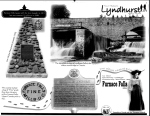
The scenic village of Lyndhurst, Ontario came into existence around 1802. Originally named Furnace Falls, it was the site of the Lansdowne Iron Works, the first iron smelter in Upper Canada. The village was established around the smelter as grist and saw mills were built in the early 1800’s. The original furnace and mill complex were destroyed in a fire in 1811.
Eventually, after the war of 1812, Furnace Falls saw the establishment of new saw and grist mills along with flour and carding mills. The population grew as farm land was settled and in 1846, the village was renamed Lyndhurst in honour of John Singleton Copley, Lord Lyndhurst. click here
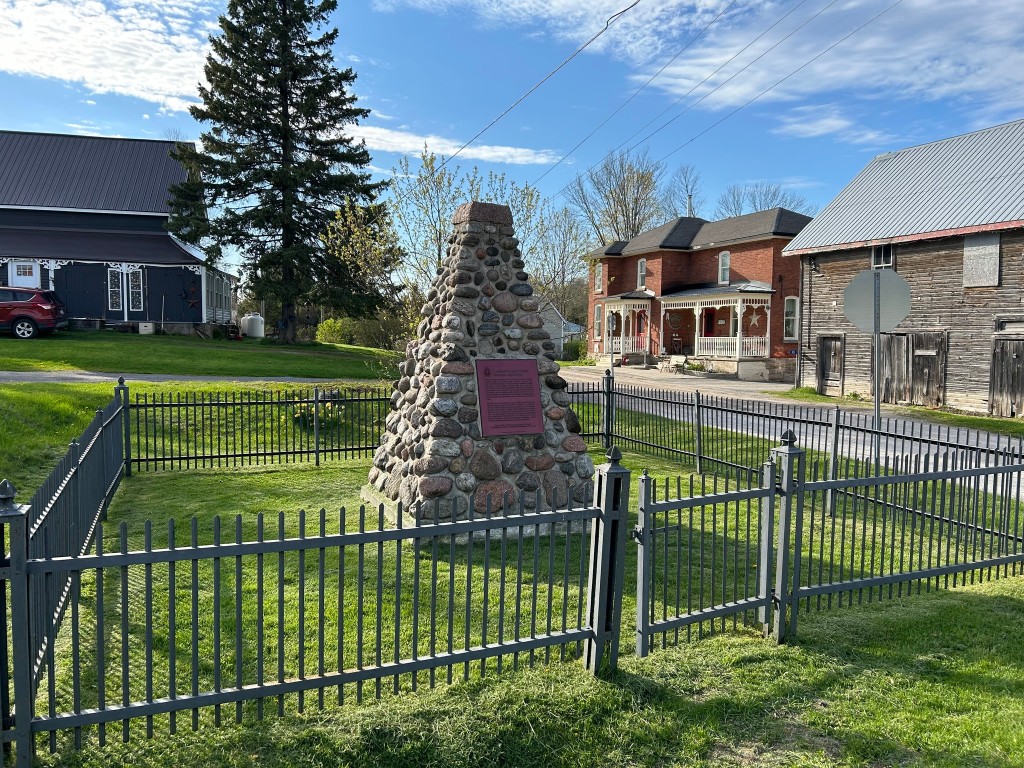
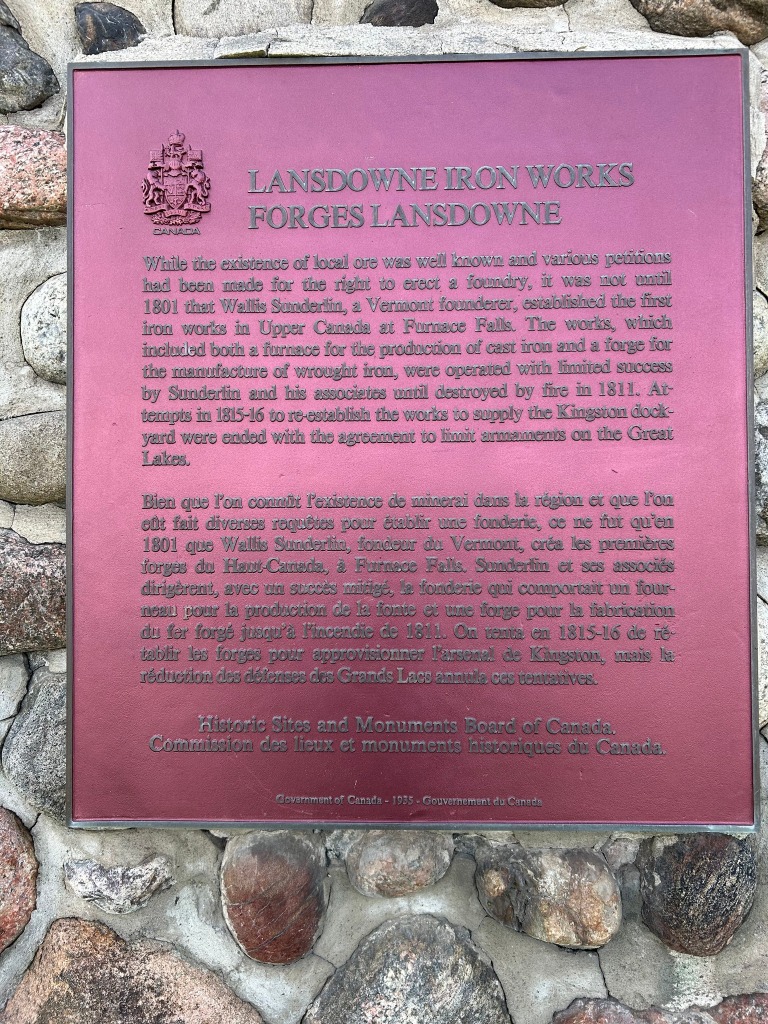
Ken Smith · — Photos from our favourite travelling historian ever…!!!!
Located near the bridge in Lyndhurst is the HSMBC memorial cairn for Lansdowne Iron Works commemorating the first iron works in Upper Canada in what was then known as Furnace Falls

1930
The Historic sites and Monuments Board has, after preliminary investigation, placed upon the agenda for its next meeting the question of designating the site of Lyndhurst (formerly Furnace Falls).
in Leeds County, of what is generally agreed to be the first blast furnace for iron that was established in Upper Canada. It was 011 Sept. 13, 1800, so General Cruikshank, the chairman of the Board has discovered, that a certain Wallace Sunderlin (sometimes referred to as “Captain”) approached the Executive Council of the province asking permission to erect works at the Big Falls of the “Gannanockway” (Gananoque) River. These works were to include a sawmill and furnace for the manufacture of “Potash Kettles” and other furnace ware that shall be necessary for the use of people in this country” and Sunderlin undertook, in addition, to build a bridge across the river and to invest the sum of $7,000 in the enterprise. Because the waterfall in question lay remote from the settled area, the land in the vicinity had yet to be allotted for patent and Sunderlin asked the Government, as encouragement and in return for his investment, to grant him a “sufficient tract of land for umber, coal and ore to carry on said business”.
He undertook to have the works completed within a year from Oct. 1, 1800, and he furnished the Executive Council with a list of persons whom he proposed to bring from the United States to assist him. The Council appears readily to have acquiesced in the suggestion. It granted him the permission he sought (with the provision that the works were to be completed within the specified time or forfeited without compensation) and the • Surveyor General was instructed to appropriate 2,400 acres of land where Sunderlin should designate, of which 1,200 acres to be his when the conditions were performed. Thus was born Upper Canada’s first iron furnace.
Sunderlin made haste to fulfill the conditions imposed by November, 1801, so Dr. Solomon Jones, an early magistrate and judge of the Johnstown District Court informed Chief | Justice Elmsley, he had erected the iron works and “a good sawmill” and had built ‘a good bridge”. Moreover, Dr. Jones reported that he had seen the forge that had been opened and “two bars of iron manufactured which appeared to be of ‘good quality” and a considerable quantity of “Coal Wood, made into Pitts and burnt into coal”, be held in the Orange Hall, January From this it may be judged how primitive were the methods Sunderlin employed. At the same time- the originator of the scheme was joined by Ephraim Jones, one of the most prominent Loyalist settlers in Augusta township and an early Member of Parliament, who also invested a sum of money, and at a later period Bradley Barlow, of Fairfield, Vermont, became a third associate. The ore used is described as “scaly red” hematite of inferior quality and limited quantity obtained on lot 25 in the tenth concession of Bastard Township. It had to be drawn a considerable distance and the supply had obvious limitations. Whether for this reason or because of other difficulties, the undertaking did not realise the expectations of those who launched it.
A certain number of pots and kettles were cast for the use of the settlers, but these are said to havep roved failures. Sunderlin sold out to his associates and, presumably, returned to Vermont. The remaining partners allowed the iron works to fall into decay. As early as 1816 it was reported they were in state of ruin and no great use WaS even made of them, to which information is oppended the opinion that “the height of the fall, the constant supply of water, abundance of ore and other advantages render it matter of regret that so valuable a property is not put to use.” To that use the property has never been put. Other mills have been operated at”Furnace Falls”, but the iron works never recovered from their decline and on attempt was ever made to revive them.
They have, indeed, become little more than a legend insofar as the people of Lyndhurst and the surrounding country are concerned. Today if one wishes to ascertain where the first iron furnace in the province was operated, one must pause in the still rather obscure village of Lyndhurst, not without admiring the beauty of its surroundings, pass across the yard of the stone gristmill and descend a steep, narrow wooden stairway that leads to the edge of the swirling stream. There, in a plot of ground used stone as a poultry yard, there may be observed under a tree that has sprung out of the foundations of the establishment; all that remains of the iron furnace. It consists of a few stout timbers, that have survived a century or more, protruding from the unpromising soil and two or three large lumps of slag–nothing more to show for Wallis Sunderlin’s enterprise and investment or to furnish proof that in this out-of-the-way spot, there was made the first attempt to put Ontario’s iron ores to commercial use..
1930

When Hiel Sliter arrived in Leeds there were seven families located between Furnace Falls now Lyndhurst and Seeleys Bay Between Seeleys Bay and what is now Kingston Mills which was still an unbroken wilderness. The nearest store was operated by Daniel Jones at Snarlingtown now Brockville. Described in his memoirs Mr Sliter describes living conditions as they existed before the War of 1812.
The corn was ground in stumps hollowed for that purpose and known as stump mills. When they had no tea they used steeped wintergreen and sometimes sage and for coffee they burned corn. Fishing and trapping were closely followed in the spring and autumn the principal fur-bearing animals being muskrats fishers otter andDeer were plentiful and furnished abundant meat for the settlers. Dresses were made of tanned deer skin and in Mr Sliter’s opinion presented a neat appearance when colored with dye made from the back of the soft maple trees.
Mr Sliter mentioned the fact that he visited Gananoque with his father in 1803 and the village consisted of three house, but in 1809 more settlers arrived and the roads in the county were much improved. The opportunities for obtaining education were meagre and Mr Sliter did not attend school until he was 15 years-of age. Those who were really desirous of obtaining some learning met in different homes in the settlement and chose the one most capable as a teacher. In this way they learned to read and write
Farm implements were crude and consisted mostly of what was known as the bull plow a heavy grub hoe a flail for threshing and a hand fan for cleaning the grain. Mr Sliter made his harness from the bark of the hickory tree. About 1800 a company was formed and a furnace built at Furnace Falls for the manufacture of bar iron. A forge was added but the fact that the ore was of an inferior quality and had to be drawn some distance made it rather expensive and the venture was not a success.
Later an attempt was made to manufacture pots and kettles for the settlers but this also proved a failure. Mr Sliter in his memoirs says the lack of schools religious service and the fact the furnace was kept burning on Sundays led to non observance of the Sabbath Day. He also tells of the scarcity of cash until the outbreak of war in 1812 when a heavy expenditure of British coins led to a rise in prices. Nails sold as high as 25 cents per pound, Oxen sold as high as $150 per head, cows as high as $40, flour was $20 per barrel pork, $40 per barrel, and salt sold as high as 50 cents per quart.
At the outbreak of the War of 1812 Mr Sltier enlisted in a rifle company stationed at Gananoque. It was there he learned the multiplication tables from British officers using a box stove as a blackboard. He served at Gananoque, Prescott, Johnstown and was later placed in charge of a boat carrying supplies from Kingston to Toronto. In 1813 his father hired as a substitute for six months in a company of Fitzgibbons and was stationed at Prescott. He was paid the Government allowance and $100. He was placed in the engineering department. Complaints were coming in to the commanding officer that there were too many canteens near the works. Mr Sliter was ordered to removed them with a band of men which he did and the cleaned space for many years afterwards was known’ as Sliter’s Plot.
After the war Hiel Sliter married Anna Sweet and their family consisted of four sons and two daughters They were: Washington and Emestus farmers, Percival a Baptist minister, Alonzo a school teacher, Alzina and Emily a teacher who had as one of her pupils the late J R Dargavel. She later became Mrs (Dr) Emerson and her sister Alzina Mrs Allen Mr Sliter’s sister Eunice became Mrs John Wheeler and they settled near him.
Mr Wheeler was taken ill while attending jury at Brockville and Mrs Wheeler on getting word of his illness walked all night through mostly wilderness and by blazed trails a distance of 30 miles reaching his bedside shortly before his death. For some time after the war Mr Sliter and his brother David engaged In lumbering. The outlet was the Gananoque River and the principal buyers were the McDonalds of Gananoque. During his lifetime Mr Sliter held many public appointments. He was prominent as a Baptist layman was made a justice of the peace and elected a member of the first County Council that met at Brockville. He died at the age of 95 years and his son Washington also lived to be 95 and his sister Mrs Wheeler lived to be 94 years. Among Mr Sliter’s descendants now living are Mrs Minnie Ruddich of Brockville Mrs Leander Chapman – Athens Mrs D McKibbon of Addison Mrs Spencer Cummings Gananoque Mrs Everett Caird Deer River NY and Chester Sliter Alexandria Bay.
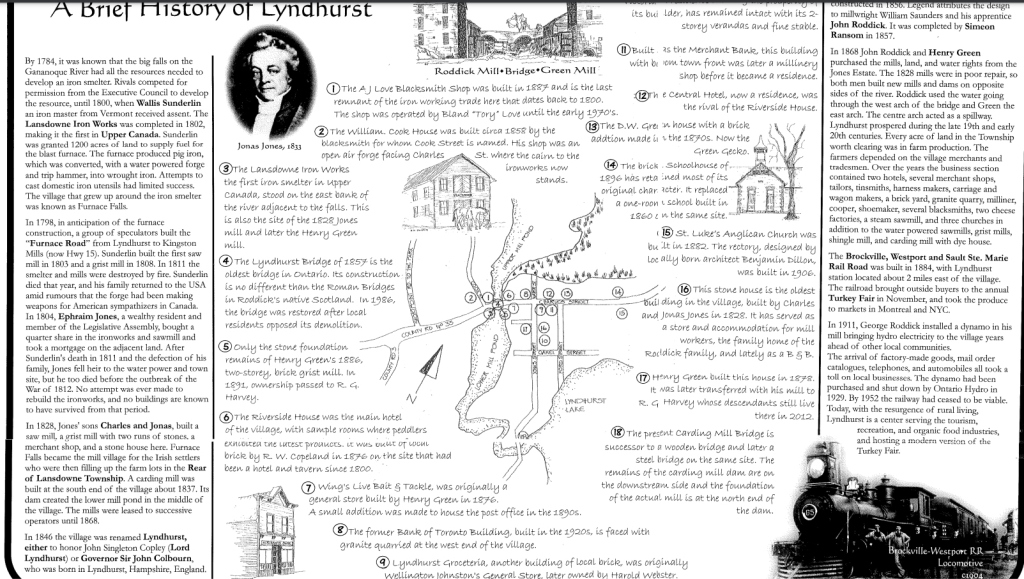
1928
Definite trace has been found within the last few weeks of the first smelter to be built and operated in Upper Canada. The furnace was erected about a half mile south of this village on property which is now owned by Mr. F. W. Bresee.
In a week or two the government is to be approached, and asked to place a tablet on the site –Furnace Falls. Because of the mining activities which went on in the vicinity of this village and because of the smelter being located here, Lyndhurst was formerly known as “Furnace Falls.” But, present years ago it was changed to its Lyndhurst. Records which have come up through the years but which were only brought to light very recently show that the smelter was erected. on land then owned by A. J. Halladay. This property was later acquired by Henry Green, father of D. W. Green,, who operates a store here at the present time. It was purchased as a double lot many years ago by Mr. F. W. Bresee, local postmaster, whose home is built near the site of the first smelter which, of course, has been razed. The furnace was completed in 1786, exactly one hundred and forty two years ago. It was used for smelting down iron and proved very successful for a time.
Internal troubles in company offices was the cause of eventual discontinthe nance of the business, it is said today. Great interest is taken in the news of the recent finding among local citizens, and they all sincerely hope that the government will see fit to place a tablet on the site. Interesting to, many people will be the fact that the exact site of the furnace can be ascertained by reason that the minerals, which were used, have colored the ground, staining it a much deeper color than the soil about it. Mining was active in this vicinity ago, and the Long Point Road was at one time the scene of years great activity. Besides the iron that was brought to the smeltors there were also large quantities of lead and other minerals moved into the village, and there put into to shape for the uses to which they were destined. The reason that the furnace site is a half mile from the village forms an interesting in present itself. The coming of the railway drew the people away from the earlier site of the village, till today the old village is no more..
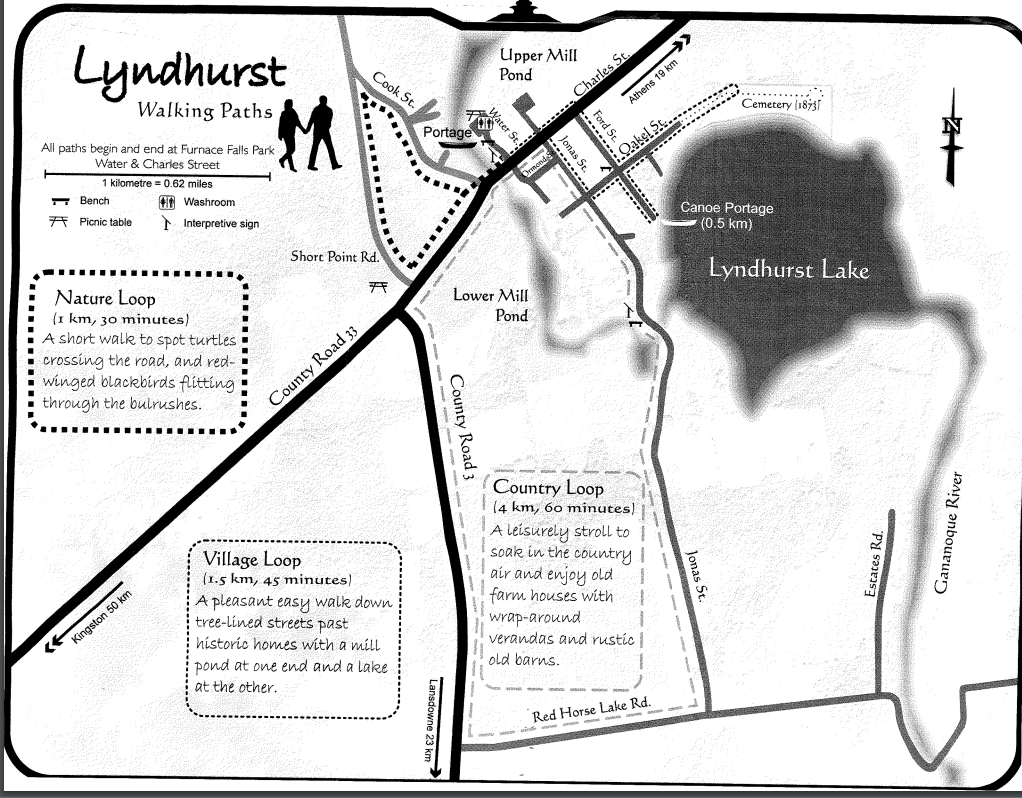
Lansdowne Iron Works – 2019 Archaeological Report
1
ARCHAEOLOGY WRAP-UP 2019
by
Art Shaw
This year’s final phase of archaeology on Lansdowne Iron Works was aimed at
investigating an area on the east bank of the river, where we had been prevented from
digging previously by large pieces of machinery from the 1881 brick flour mill. We
began site preparations in early August. In the first week of August I built a new
gangplank over the washout, which has grown since our first attempt here. A tall
section of the stone mill foundation had developed a pronounced lean to the south, over
the site where the pits were proposed. In the second week, with the help of Zane
Kelman and Michael Whittaker, we rigged a system of planks and ropes anchored to a
tree on the north side of the foundation, to hold tension against any movement of the
wall. Then in the third week we took advantage of the services of a boom truck from G.
C. Hudson Supply in Brockville (solicited by Dave Johnson) to bring the old machines
up to the level of Ormond St. This required extracting the machines from the rubble,
where they were entangled in masses of tree roots up to three inches thick. Jack Harvey,
Dave Johnson and myself moved tons of brick and stone rubble and chopped roots and
shoveled soil to free them. The lowest one was badly broken by the others falling on it,
and in the end we removed it by further breaking and cutting it to pieces. read more here… click

Mother Barnes- The Witch of Plum Hollow – Grain Thefts etc. — Mother Barnes series

